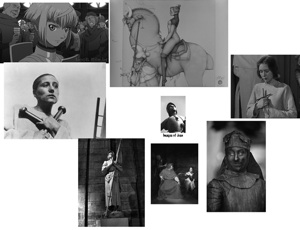Order McKenzie books online with a credit card
Bring Jamie to your school or district for a great workshop.
May Issue
Vol 23|No 5|May 2014
 |
What is real?
|
As far as we know, there is no image of Joan of Arc available today that was created by anyone who actually saw Joan while she was alive, and yet there are dozens of images available purporting to be Joan, some of them book covers, some advertising movies and others proclaiming her sainthood. |
There are heaps of information readily available, but how much of it is believable and trustworthy? How do we teach our students to distinguish between the true and the false? between propaganda and fact? The validity and reliability of the information become critically important when making treatment choices, selecting products or determining a course of action. School research should frequently engage student in such authentic activities so they can appreciate the importance of credible sources. Authentic LearningFred Newmann's concept of “authentic teaching” involves students in “authentic intellectual work” outside school. Instead of busy work - repetitive tasks that require little thought and involve mere scooping, smushing, memorizing and regurgitating - Newmann's approach immerses students in challenges that demand imagination, resourcefulness, persistence and stamina. They also highlight the importance of credible sources. Even though some of these activities may be staged or simulated, they still pass the test of authenticity because they meet the following criteria:
For more information about this approach, consult these two articles: This article will provide three examples of authentic learning, one applied to a treatment choice, one applied to a product selection and one focused on solving a problem. Example One - Acne Treatment ChoiceYoung people are frequent targets of cosmetic and pharmaceutical companies that make promises regarding their skin, their body odor, their dating success and their moods. In evaluating these claims, students might ask what evidence the company provides to prove their ointment will actually take care of their acne without harmful side effects. The following Web site from Sephora might be a great place for students to begin their research. ACNE - WHAT IT IS & HOW TO TREAT ITFor young people with severe acne, some doctors have prescribed Acutane. There are serious side effects listed for this medication, and Roche, the manufacturer, stopped making it after losing some big lawsuits, but it also seems to work for some patients. Ask students if they would take such medication after having reviewed the evidence. What other treatment choices would make good study units? Perhaps the students can suggest follow up studies once they have wrestled with the acne challenge. Example Two - Product SelectionThe Internet provides voluminous data regarding products and services ranging from cars, refrigerators and sound systems to doctors, lawyers and restaurants. Just because there is a huge amount of information does not mean there is sufficient credible evidence upon which to base a decision. It is not difficult for teachers to select a product that might be of interest to a class and ask them to compare and contrast the digital cameras, smart phones or mountain bikes offered by competing brands. Another option is to challenge students to compare and contrast local restaurants starting with their Web sites and their reviews on sites like Yelp or TripAdvisor. The ratings of customers can very dramatically and will sometimes shock students with the variance between what they read and what they have experienced personally in those same restaurants. Example Three - A Course of ActionProblem-based learning asks students to explore an important issue with an eye toward creating an action plan meant to bring about important changes. "Connecting the Dots" provides an extended description of this approach as applied to the question, "What should we do about floods." There are dozens of issues that lend themselves to this kind of unit.
As students conduct their research, ask them to pay special attention to the validity and reliability of the sources they will encounter. While many Web sites may offer assistance, how much is trustworthy? GM pretty much ignored thousands of complaints as customers died in defective automobiles. "Families Of Victims Want GM Prosecuted For Car Defects" The GM experience and the Roche experience both serve as a warning to students about handling problems consumers may face at the hands of large corporations with products that may do harm. As they explore local issues like flooding and traffic, they may also encounter faulty information from local officials who have an interest in down-playing the seriousness of threats and problems.
Developing an Eye for the Bogus and the MisleadingWhen reliable information is required to make a smart decision, the capacity to identify false and misleading sources becomes paramount. It is a capacity that must be developed and sharpened like a set of knives. Authentic learning activities like those suggested above provide the opportunity to hone this capacity.
|
From Now On is published by FNO Press
Network 609
935 Lincoln Pl
935 Lincoln Pl
Inquiries via email please
Order online with a credit card
Copyright
Written materials, art work and photography on this site are copyrighted by Jamie McKenzie and other writers, artists and photographers. Written materials on these pages may be distributed and duplicated if unchanged in format and content in hard copy only by school districts and universities provided there is no charge to the recipient. They may also be e-mailed from person to person. All other uses, transmissions and duplications are prohibited unless permission is granted expressly. Showing these pages remotely through frames is not permitted.
FNO is applying for formal copyright registration for articles.




